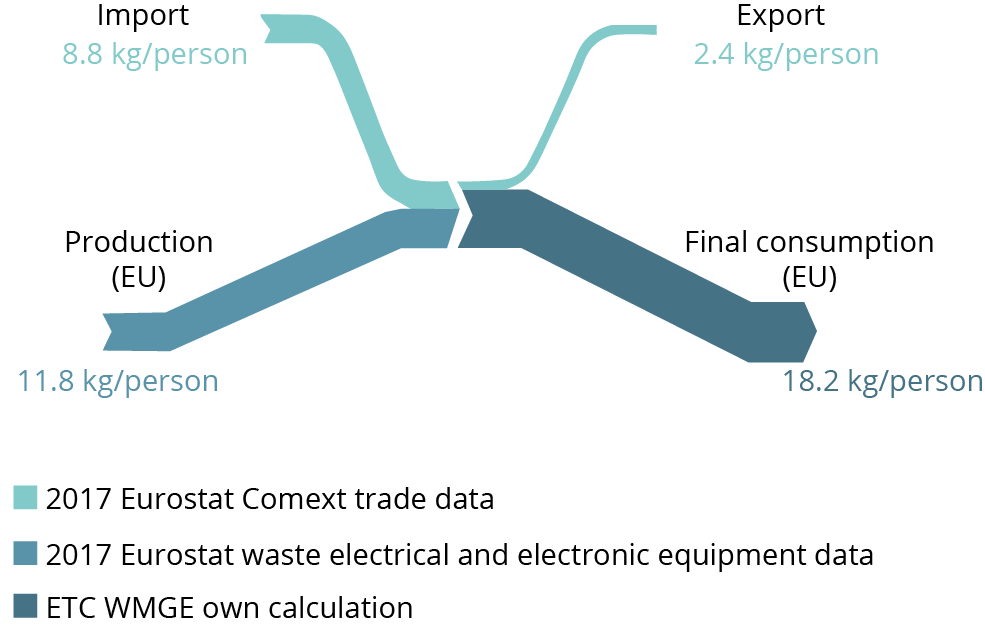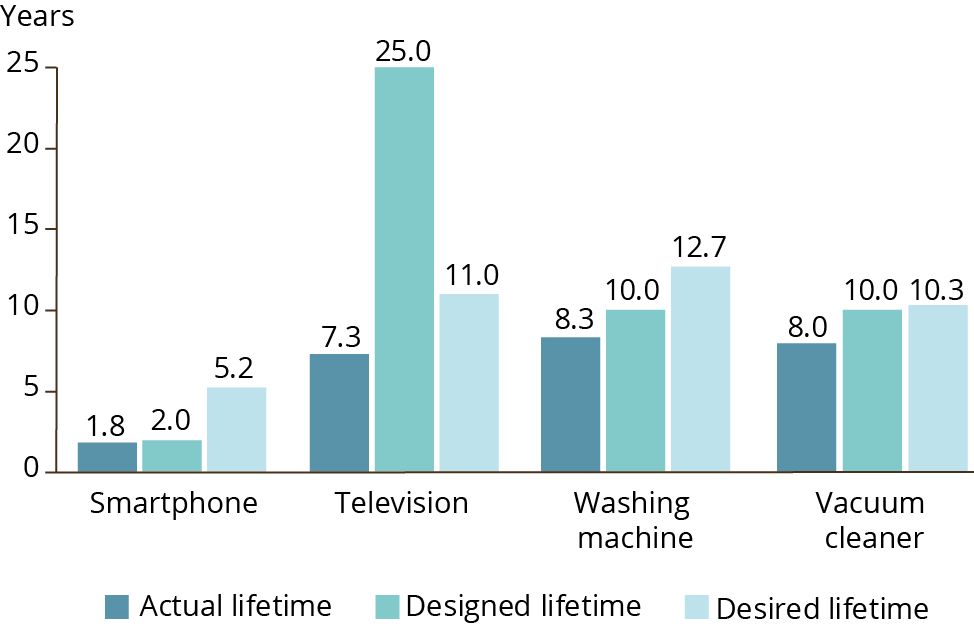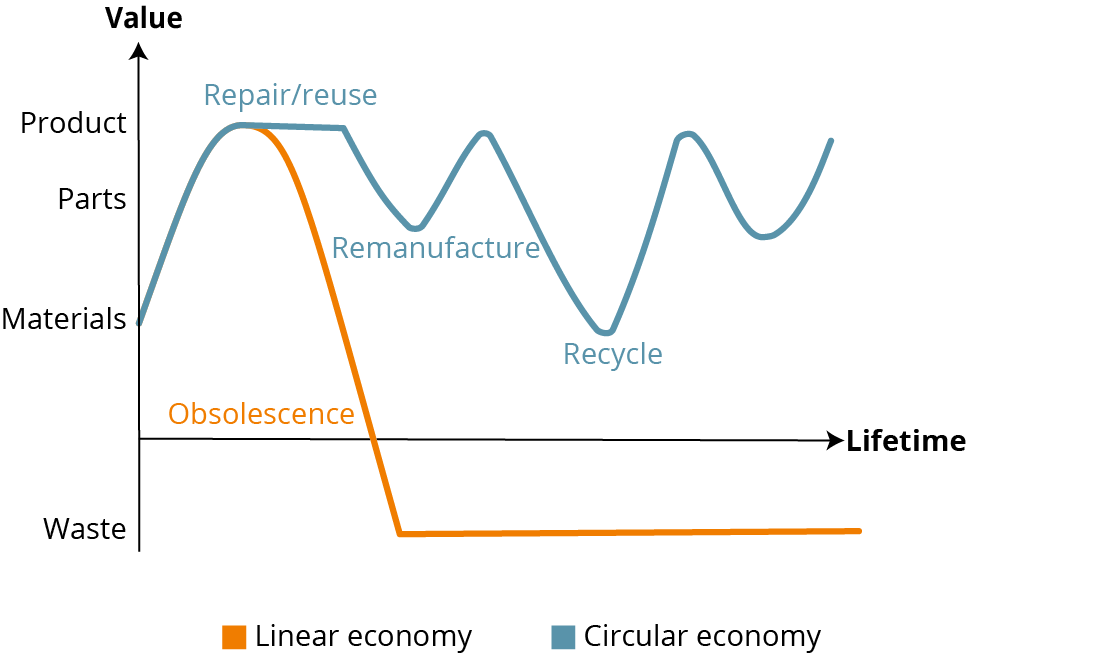A report on ‘electronics and obsolescence in a circular economy’ from the EEA’s European Topic Centre on Waste and Materials in a Green Economy (ETC/WMGE) underpins this analysis. Case studies on smartphones, washing machines, vacuum cleaners and televisions, summarised in this briefing, can be read in full in the report.
Electronics: production, consumption and trade
Every year, we produce more items of internet-related electronics than there are humans (WEF, 2019). Growing supply and demand has resulted in the electrical and electronics industry developing into one of the largest industrial sectors. In 2017 the electronics manufacturing sector in Europe employed over 2.5 million people in 86,200 enterprises with a turnover of 705 billion EUR (Eurostat, 2019b).
European households use a large variety of electronics from appliances for housekeeping such as vacuum cleaners, washing machines and refrigerators to electronics and gadgets such as mobile phones, computers and televisions. In 2017, EU households spent on average five per cent of their total expenditure on electrical and electronic products (Eurostat, 2019c). In 2017, 20.6 kg of electrical and electronic goods per person were put on the market in the EU (Eurostat, 2019a). Of that, roughly 60 per cent (11.8 kg) was produced within the EU and 40 per cent (8.8 kg) was imported (Eurostat, 2019d). The EU exported 2.4 kg per capita (Figure 1).

Reference: ETC/WMGE based on Eurostat, 2019a and Eurostat, 2019d.
Note: The waste flow of electronics from stock is not included in this scheme
Lifetime, environmental impacts and circularity potentials
The amount of electronics put on the market in the EU has been increasing rapidly over the past decades (Eurostat, 2019a). This can partly be explained by increasing consumption trends. But it can also be explained by shorter lifetimes and increasing obsolescence of electronic products, i.e. that the products are no longer used while they are in principle still functioning, or could be functioning if repaired.
There are a number of reasons for shorter lifetimes and increased obsolescence of electronics (Cooper, 2016). In particular, rapid technological developments mean that models become obsolete quickly either in the eyes of the consumers or because the hardware is no longer compatible with updated software. Marketing-induced obsolescence also encourages the purchase of new models that may offer only minor improvements on existing models. Other drivers of consumer demand include: a decline in the quality of many products; consumer demand for the latest design, technology, or increased energy efficiency of new products. Repair options for many electronics are also limited either because the design does not allow easy repair or because repair costs are high compared to buying a new product. The result is that electronics that could be repaired are often discarded. However, repair services for electronics are growing within the EU both for business to business and end consumers.
One can look into the lifetime of electronic products by comparing the actual lifetime with the designed and desired lifetimes:
- Actual lifetime refers to the interval from when a product is sold to when it is discarded or replaced.
- Designed lifetime is the lifetime that a manufacturer intends its product to remain functional - shaped through design and after-sale service etc.
- Desired lifetime has been defined as the average time that consumers want products to last.
The difference between actual, designed and desired lifetimes of smartphones, vacuum cleaners, televisions and washing machines (which were analysed in the case studies underpinning this briefing) are shown in Figure 2.

Sources: ETC/WMGE based on Cordella et al., 2019 and Wieser et al., 2015 for smartphones; Kalyani et al., 2017, King County, 2008 and Wieser et al., 2015 for televisions; Wieser et al., 2015 for washing machines; Rames et al., 2019, EC, 2019 and Wieser et al., 2015 for vacuum cleaners)
For all four product groups, either the designed or the desired lifetime is at least 2.3 years longer than the actual lifetime, showing potentials for significant and varying increase in practical operating lifetimes.
Environmental and climate impacts from electronics include those arising from material use, emissions of air pollutants and greenhouse gases, chemicals use and waste in particular. In complex electronic equipment up to 60 separate chemical elements can be found. There are also very significant environmental and social impacts from the extraction and use of these materials including from mining and production of copper, critical raw materials (CRMs) and rare earth elements (REE) as well as from metals, such as tantalum, plastics and glass. Impacts include contributing to resource scarcity, water use, and pollution from chemicals.
The impact of different electronic products over each phase of the life cycle varies significantly. For some, such as washing machines and tumble dryers, most emissions are from the use phase, while for mobile phones, most emissions are from resource extraction and production. Use of chemicals in mining and production processes are also of concern, including in terms of pollution of the natural environment and as human health hazards.
When electronics enter the end-of-life stage, they become waste electrical and electronic equipment (WEEE). This is one of the fastest growing waste streams in the world with an annual growth rate of 4 per cent or 44.7 million tons in 2016 (Baldé et al., 2017). In the EU-28,[1] the generation of WEEE for 2017 was 10.4 million tons, slightly above 20 kg on average per inhabitant (Eurostat, 2019a). Around 44 per cent of this volume was collected.
In order to minimise the environmental impacts of electronics it is important to increase product lifetimes. Circular business models—including circular design, product as a service, re-use and recycling—need to be scaled and supported by policies. Figure 3 provides an illustrative indication of how the value of electronics can be retained in a more circular electronics production and consumption system with repair and re-use, remanufacturing and recycling. This is contrasted to a traditional linear economy, where the value is lost with short lifetimes.

Source: ETC/WMGE
A range of measures will be required to support the scaling up of circular business models for electronics, including:
- strengthening eco-design requirements to prioritise longer lifetimes;
- improved end-of-life disposal/re-processing potentials;
- continued development and use of the EU Energy Label to help decision-making by consumers;
- further development of green public procurement (GPP) to create additional demand for environmentally friendly products;
- the extension of producer responsibility to end of life as a key incentive towards ‘production for circularity’“;
- forthcoming EU Eco-label criteria for electronic displays and
- an electronic product passport to provide information on the origin, composition and repair possibilities of a product as well as its possible end of life handling.
Responding to challenges and options such as those addressed in this briefing, the recently announced Circular Economy Action Plan (EC, 2020) of the European Commission addresses electronics and Information and Communication Technologies (ICT) as one of its key product and value chains. The Commission further intends to present a Circular Products Initiative mobilising existing and new policy instruments (EC, 2020). It will promote longer product lifetimes through a variety of actions, including regulatory measures under the Eco-design Directive, implementing the “right to repair” regulatory measures for chargers, improving collection and treatment of waste electrical and electronic equipment and review EU rules on restrictions of hazardous substances in electrical and electronic equipment.
Smartphones, televisions, washing machines and vacuum cleaners
In order to look into lifetimes and environmental impacts of electronics in more detail, four case studies have been elaborated as part of this study, for smartphones, LCD televisions, washing machines and vacuum cleaners. The materials used in an electronic product is an important factor in determining the lifetime and possible obsolescence of that product. The materials used in electronics vary considerably, as shown in Figure 4. For smartphones, the main material is glass followed by aluminium, copper and critical raw materials. For LCD televisions, the main materials are iron, plastic and glass. Vacuum cleaners are also mainly made with plastics and iron, while washing machines are made mostly from iron, concrete and plastics.
Source: ETC/WMGE based on Manhart et al. 2016; CECED, 2017; Huisman et al., 2007.
Smartphones
Smartphones came onto the market in the late 1990s and gained huge worldwide popularity with the launch of the iPhone in 2007 (Statista, 2018). Globally, over 1.5 billion smartphones are sold annually (Statista, 2019a). They are very often replaced before they are broken. The most common reasons for replacing a smartphone—on average after less than two years (Cordella et al., 2019)—are that consumers want to have the latest model, marketing-induced obsolescence or because the existing phone is not functioning properly, most often related to broken screens, battery lifetime or operating system problems (Cordella et al., 2019; Watson et al., 2017).
When looking at the lifecycle greenhouse gas (GHG) emissions from smartphones, studies show a wide range of estimated total GHG ranging from 16 to 110 kg CO2 equivalents for different models, which is a relatively moderate amount (Manhart et al., 2016). It is the very large total product volume that causes, aggregately, high environmental and climate impacts, mostly from manufacturing, but also from charging and use. From an environmental and climate perspective, smartphones should be kept and used for longer.
Televisions
In Europe 95 per cent of households own at least one television (EC, 2018a) and approximately 70 million units were sold in Europe in 2018, around 15 per cent of the global volume (Statista, 2019b; Statista, 2019c). Smart televisions consume more energy than their unconnected counterparts. Purchasing a new television instead of repairing the broken one has become more customary. This has led to shorter average lifetimes of televisions of just over seven years, with an even faster turnover in recent years (Wieser et al., 2015).
The main reasons for obsolescence and shortened lifetimes include the hardware not matching new software and lack of repair services.
In terms of environmental and climate impacts, the actual manufacture of an LCD television contributes to around half of the 300 kg CO2e/year estimated GHG emissions for the entire life cycle of the product (Manhart et al., 2016). Linking this with the increase in energy consumption of new televisions, from an environmental point of view it is desirable to use older, more energy efficient products, for as long as possible.
Washing machines
There are over 200 million washing machine units in Europe, and 92 per cent of households have one (Boyano et al., 2017). Each household uses the washing machine 3.8 times per week on average (Boyano et al., 2017). Consumers replace the washing machine mainly because the old machine is broken, on average after approximately 8 years (Wieser et al., 2015). Washing machines are designed for a specific service life or number of cycles. The actual lifetime of the washing machine has decreased over recent years and is less than the average consumer’s expectations of a 12.5 year lifetime (Boyano et al., 2017).
Up to 75 per cent of the lifecycle environmental impact of washing machine comes from the use phase (EEB, 2019). It is environmentally beneficial to extend the lifetime beyond their actual lifetime. A UN study shows that it would make sense to replace a washing machine once it is at least 10 years old and if the new model is significantly more energy efficient (Bakker and Schuit, 2017). Therefore, there is a trade-off between a longer lifetime versus an improved new product with better energy and resource efficiency.
Vacuum cleaners
The four main types of vacuum cleaners are cylinder or canister, upright, handheld and robotic (EC, 2019). The lifetime of domestic vacuum cleaners is on average 8 years and is expected to decrease (Rames et al., 2019). According to consumer surveys published by the European Commission, over 40 per cent of the participating consumers indicated not to have repaired the vacuum cleaner the last time it broke down (EC, 2018b). The most important reasons for not repairing the vacuum cleaners are the cost and a preference for a new, possibly more fashionable model.
Vacuum cleaners are responsible for 0.79 per cent of the total EU electricity consumption and 0.21 per cent of the total EU emitted GHG (EC, 2019). Although the energy consumption in the use phase has decreased, it still accounts for around 70 per cent of total energy consumption in the life cycle (EC, 2019). With a decreasing product lifetime and increasing popularity of more complex cordless and robotic cleaners, the impact of the manufacturing phase will increase and will require appropriate measures.
Document Actions
Share with others